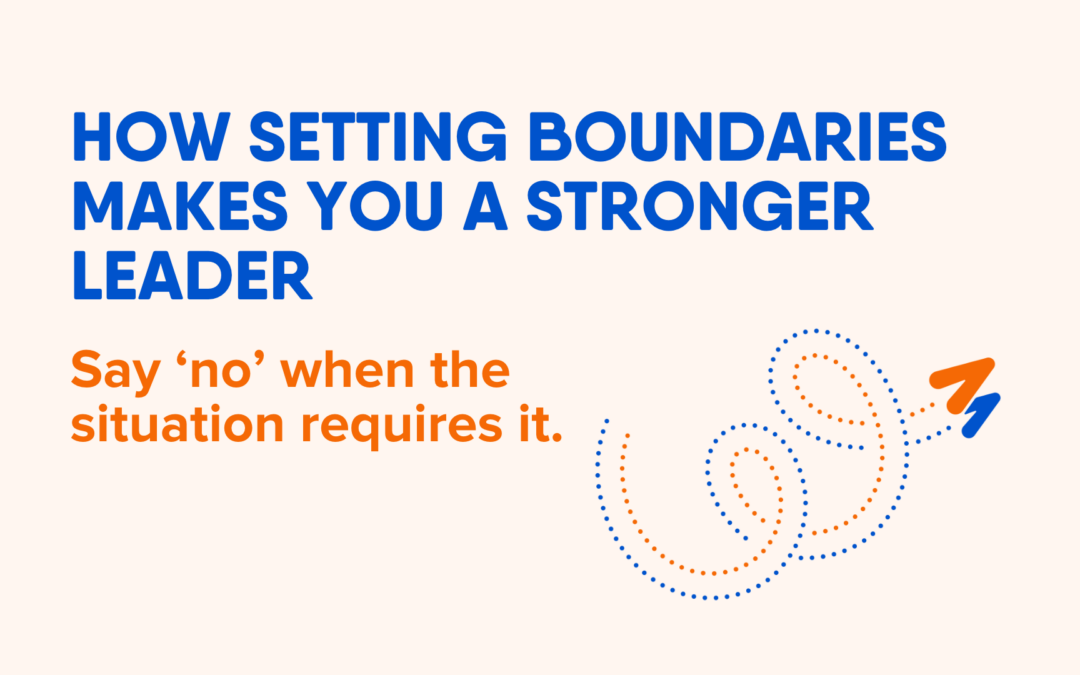Being a leader means pushing yourself beyond your comfort zone. In this challenging period for the world and organizations, leaders need to be courageous and take daring action.
Strong leaders are willing to step up and say ‘no’ when the situation requires it. They set boundaries, trust their intuition, and stand for what they believe in. These are not easy things to do, but as we see more examples of courageous leaders taking a stand, we also see how much better the world is because of them.
To become stronger as a leader, you need to grow in setting boundaries, trusting your intuition, and standing up for what you believe in. These can open new doors for your growth.
What Does It Mean To Set Boundaries?
Boundaries are limits that you place on yourself and how you interact with others. They help you to know how much you are willing to take on. There are two types of boundaries: physical and emotional.
Physical boundaries include how much sleep you get and how much time you spend in the office. Emotional boundaries include how much energy and attention you give to other people.
Strong leaders can set both physical and emotional boundaries. Setting boundaries means that you are taking care of yourself. It communicates to the people around you that you respect yourself and that you have enough self-awareness to know how much you can handle. It also communicates that you care about other people’s feelings.
Why Is Setting Boundaries Important For Leaders?
Strong leaders are willing to say ‘no’ when the situation requires it. They know when to let go of situations and people who are not good for them. They set boundaries so that they can spend their time and energy on what is most important. Setting boundaries is important to protect your mental, emotional, and physical health. Strong leaders are able to be resilient in the face of challenges and they know how to get the support that they need when they are feeling stressed.
Setting boundaries enables you to do this. Setting boundaries is important for your relationships with others. If you are feeling overwhelmed, it can be hard to be a supportive and caring leader. Setting boundaries means saying, “I care about you, but I also have to look after myself.” It helps you to avoid getting into situations that will benefit neither you nor the other person.
Set Boundaries More Effectively
There is no one-size-fits-all approach to setting boundaries. It is something that you need to be mindful of in every situation. Here are a few tips to help you set boundaries more effectively.
1 – Acknowledge what you want.
Before you can set any boundaries, you need to know what you want. If you don’t know what you want, you won’t be able to say ‘no’ when the situation requires it.
2- Be specific.
It can be difficult to say ‘no’ when you want to be helpful. If someone asks you to do something, take a moment to think about whether or not you want to do it. If you aren’t sure, then say ‘no’. You don’t have to justify your decision to anyone.
3 – Set a time frame.
If you are helping someone out and you know that you will eventually be able to let go of the situation, set a time frame for when you will finish helping them. If you aren’t sure when you will be able to let go, then you may not have the bandwidth to take on the responsibility.
4 – Use ‘I’ statements.
You can set a boundary by saying ‘no’ firmly and respectfully. Use ‘I’ statements to avoid putting the other person on the defensive. Instead of saying, ‘you are asking too much of me,’ you could say, ‘I am not able to commit to that project right now.’
Trusting Your Instincts Is Important For Leaders
Strong leaders trust their instincts. They have enough self-awareness to know when something is off. They know when situations aren’t good for them and when people aren’t trustworthy. Trusting your instincts is also an important way to protect your mental health. Trust your instincts when you are dealing with colleagues, customers, and other people who are important to your work. Strong leaders let go of situations when they know that they aren’t getting anywhere. They know that not everyone is going to get along and that is okay. You can trust your instincts when it comes to choosing your team members. You don’t need to know why you don’t trust a person; you need to know that you don’t trust them.
Standing Up For What You Believe Is Another Way To Grow
Strong leaders stand up for what they believe in. They can look at the big picture and understand what will be best for the organization and the people who work there. They know that vision is not just about their department or their job; it is about the whole organization and the mission. You don’t have to be the boss to stand up for what you believe in. You don’t have to be the leader of your team or even be in a managerial position to have a voice. You can choose to use your voice wherever you are.
How You Should Be Setting Boundaries at Work
Every situation and leader is different, but there are some common steps we can follow to make it happen.
1 – Identify Your Most Critical Boundaries
First, you must start by choosing the most important areas of your work that you want to protect. You can often determine this by looking for your trigger points.
Your trigger points are those times when someone’s actions continuously make you feel uncomfortable or upset.
2 – Take a Position
The next step after identifying your trigger points is to consciously take a position regarding the situation at hand. This means defining your stance on the problem, which will become your boundary position.
You can’t set a boundary if you don’t have a clear position. And you can’t defend a position if you don’t know what it is!
3 – Automate Your Boundary
In some cases, you may be able to use a system or process to help you reinforce a boundary. This can work well for managing your time, for example.
Or, you may book time in your calendar to complete specific tasks that are important to you. This locks that time away, meaning people won’t be able to book over it without your permission.
You could use a system to handle incoming work requests. Anything logged in there gets looked at, and other requests are ignored. Automating your boundaries is powerful and, in many cases, quite achievable.
4 – Be Consistent
Consistency is a huge part of setting boundaries at work. If you chop and change your position frequently, people won’t learn. Being consistent is critical because it trains the people around you to behave in a certain way. As soon as you let people transgress your boundaries, there is a chance that they will continue to be disrespected.
Resolving Conflicts
It’s important to note that you won’t always get your own way. Sometimes, your boundaries will be incompatible with the needs of the people around you.
As you begin setting boundaries at work, you will start to see these areas of potential conflict.
These conflicts are a perfect opportunity to have an open discussion about what you need and why you’re trying to put boundaries in place.
You won’t win every battle, but at least by setting boundaries, you will put a stake in the ground. If your boundaries continue to be breached, you can then make a decision about whether your current workplace or role is suitable for you.
Ready to learn more about working with us and unleashing your leadership potential?
Want to think about it some more?
Let's connect
Our social media is where we regularly share tips and content for balancing life and business and enjoying both.

